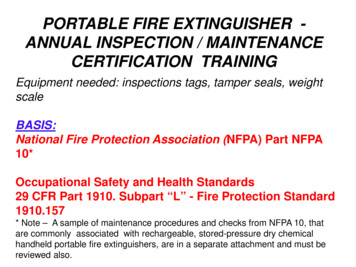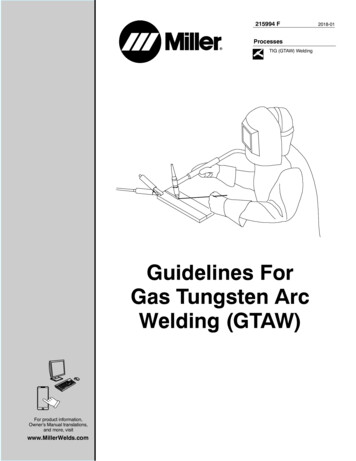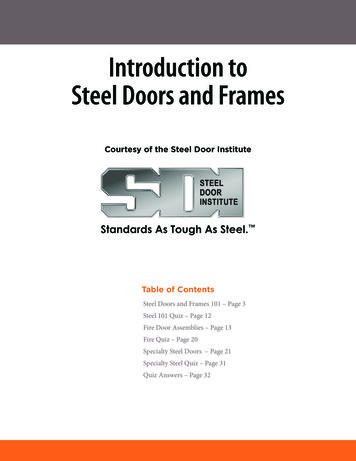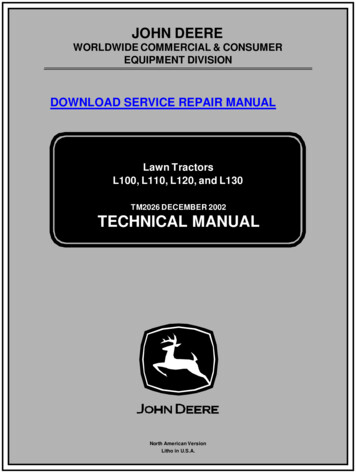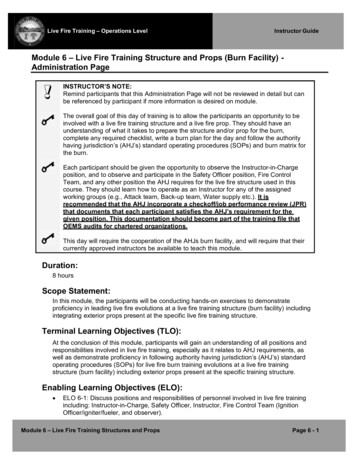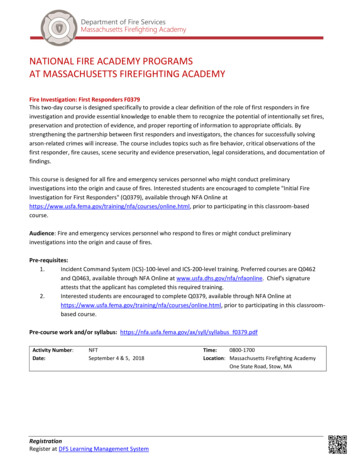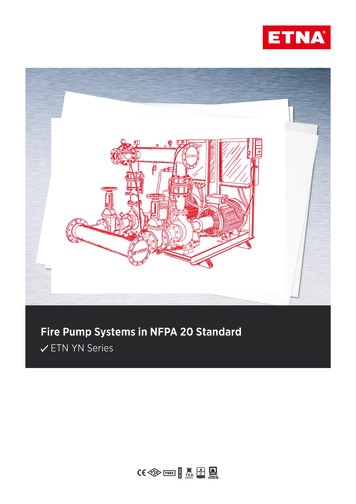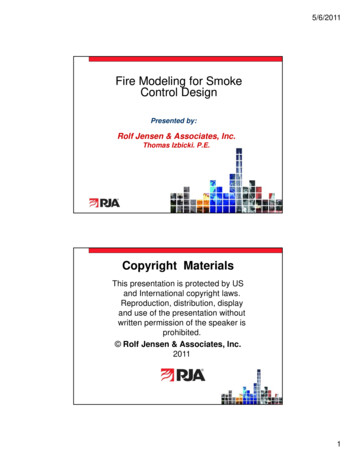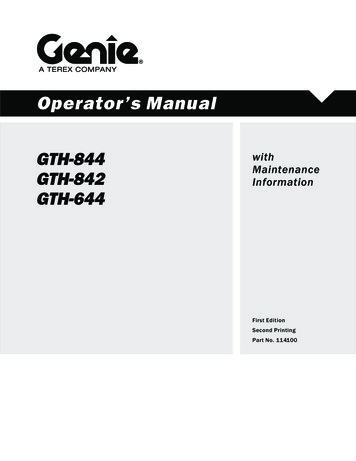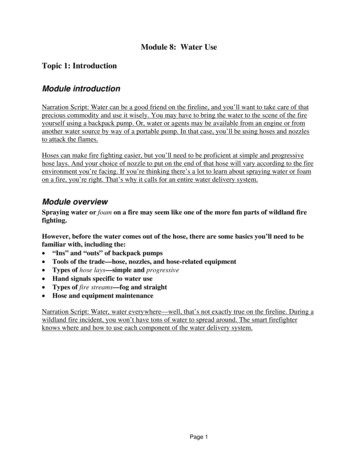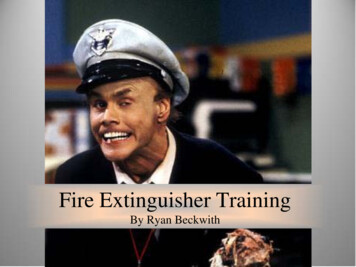
Transcription
Fire Extinguisher TrainingBy Ryan Beckwith
The Fire TetrahedronFire Safety is based upon the principle of keepingfuel sources and ignition sources separate.
The Fire TetrahedronThree things must be present at the same time toproduce fire:1. Enough Oxygen to sustain combustion2. Enough Heat to reach ignition temperature3. Some Fuel or combustible materialTogether, they produce the sustainedCHEMICAL REACTION that is fireTake away any of these things andthe fire will be extinguished.
Types of Fires Fires are classified according to the type offuel that is burning. If you use the wrong type of fire extinguisheron the wrong class of fire, you might makematters worse. There are five different fire (fuel)classifications
Types of FuelsClass A: Wood, paper, cloth, trash, plastics—solids that are not metals.Class B: Flammable liquids—gasoline, oil,grease, acetone. Includes flammable gases.Class C: Electrical—energized electricalequipment. As long as it’s “plugged in.”Class D: Metals—potassium, sodium, aluminum,magnesium. Requires Metal-X, foam, and otherspecial extinguishing agents.Class K:Vegetable oils, animal oils, or fats incooking equipment- used in commercialkitchens
Types of FuelsMost fire extinguishers will have a pictograph labeltelling you which types of fire the extinguisher isdesigned to fight.For example, a simple water extinguisher might havea label like this which means it should only be used on Class A fires.
Types of Fire ExtinguishersDifferent types of fire extinguishers are designed tofight different classes of fire.The 4 most common types of fire extinguishers are:1. Water2. Carbon Dioxide (CO2)3. Dry Chemical (ABC)4. Wet Chemical (K)
Types of Fire Extinguishers1. Water Fire ExtinguishersLarge silver fire extinguishersthat stand about 2 feet tall andweigh about 25 pounds whenfull.Filled with ordinary tap waterand pressurized air, they areessentially large squirt guns.
Types of Fire Extinguishers1. Water Fire ExtinguishersWater FireExtinguishersextinguish fire bytaking away the“heat” element ofthe Fire Tetrahedron.
Types of Fire Extinguishers1. Water Fire Extinguishers Water Extinguishers are designed for Class Afires only: Wood, paper, cloth. Using water on a flammable liquid fire couldcause the fire to spread. Using water on an electrical fire increasesthe risk of electrocution.
Types of Fire Extinguishers2. Carbon Dioxide Fire ExtinguishersA CO2extinguisherlacks a gaugewhich iscommon onother types ofextinguishers.CO2 cylinders are red. They range in size from 5lbs to 100 lbs or larger. On larger sizes, the hornwill be at the end of a long, flexible hose.
Types of Fire Extinguishers2. Carbon Dioxide Fire ExtinguishersCO2’s are designed for Class B and C(Flammable Liquids and Electrical Sources)fires only!CO2 extinguishers will frequently be found in laboratories,mechanical rooms, kitchens, and flammable liquid storageareas.
Types of Fire Extinguishers2. Carbon Dioxide Fire ExtinguishersCarbon dioxide is anon-flammable gasthat takes away theoxygen element ofthe fire tetrahedron.Without oxygen,there is no fire.CO2 is very cold as it comes out of the extinguisher, so itcools the fuel as well.
Types of Fire Extinguishers2. Carbon Dioxide Fire ExtinguishersA CO2 may be ineffective inextinguishing a Class A fire because itmay not be able to displace enoughoxygen to successfully put the fireout. Class A materials may alsosmolder and re-ignite.
Types of Fire Extinguishers3. Dry Chemical (ABC) Fire ExtinguishersDry chemicalextinguishers putout fire bycoating the fuelwith a thin layerof dust. Thisseparates the fuelfrom the oxygenin the air.The powder also works to interrupt the chemical reaction offire. These extinguishers are very effective at putting outfire.
Types of Fire Extinguishers3. Dry Chemical (ABC) Fire ExtinguishersABC extinguishers arered and have a gaugeon the top of them.The usually have aflexible rubber hoseon them.
Types of Fire Extinguishers3. Dry Chemical (ABC) Fire Extinguishers Dry chemical extinguishers are filled with either foam or powder,usually sodium bicarbonate (baking soda) or potassium bicarbonate,and pressurized with nitrogen. Baking soda is effective because it decomposes at 158 degreesFahrenheit and releases carbon dioxide (which smothers oxygen)once it decomposes. Dry chemical extinguishers interrupt the chemical reaction of thefire by coating the fuel with a thin layer of powder or foam,separating the fuel from the surrounding oxygen.
Types of Fire Extinguishers3. Dry Chemical (ABC) Fire ExtinguishersDry chemicalextinguishers come ina variety of types You may see them labeled: DC (for “Dry Chemical”) ABC (can be used on Class A, B, or C fires) BC (designed for use on Class B and C fires)
Types of Fire Extinguishers3. Dry Chemical (ABC) Fire ExtinguishersDry chemical extinguishers withpowder designed for Class B and Cfires (“BC” extinguishers) may belocated in places such as kitchensand areas with flammable liquids.
Types of Fire Extinguishers4. Class K (wet chemical) Fire ExtinguishersThese fire extinguishers work onthe principal of saponification.Saponification takes place whenalkaline mixtures such as potassiumacetate, potassium citrate orpotassium carbonate are applied toburning cooking oil or fat.
Types of Fire Extinguishers4. Class K (wet chemical) Fire ExtinguishersThe alkaline mixture combinedwith the fatty acid create a soapyfoam on the surface which holds inthe vapors and steam andextinguishes the fire. Allcommercial kitchens are required tohave a class K extinguisher.
How it’s made
How to Use a Fire ExtinguisherIt’s easy to remember how to use a fire extinguisher if youremember the acronym PASS: PullAimSqueezeSweep
How to Use a Fire ExtinguisherPull the pin This will allowyou todischarge theextinguisher
How to Use a Fire ExtinguisherAim at the base of the fire Hit the fuel.If you aim atthe flames. the extinguishing agent will fly rightthrough and do no good.
How to Use a Fire ExtinguisherSqueeze the top handle This depresses abutton thatreleases thepressurizedextinguishingagent.
How to Use a Fire ExtinguisherSweep from side to side . until the fire iscompletely out.Start using the extinguisherfrom a safe distance away,then slowly move forward.Once the fire is out, keep an eye on the area in caseit re-ignites.
Rules for Fighting FiresBefore deciding to fight a fire, be certain that . The fire is small and not spreading. A fire can double in sizewithin two or three minutes. You have the proper fire extinguisher for what is burning. The fire won't block your exit if you can't control it. A good wayto ensure this is to keep the exit at your back. You know how to use your fire extinguisher. There's not enoughtime to read instructions when a fire occurs
Rules for Fighting FiresHow to fight a fire safely: Always stand with an exit at your back. Stand several feet away from the fire, moving closer once the firestarts to diminish. Use a sweeping motion and aim at the base of the fire. If possible, use a "buddy system" to have someone back you up orcall for help if something goes wrong. Be sure to watch the area for awhile to ensure it doesn't re-ignite.
Use Caution When Fighting FiresNever fight a fire if: The fire is spreading rapidly. Only use a fire extinguisher whenthe fire is in its early stages You don't know what is burning. Unless you know what isburning, you won't know what type of fire extinguisher to use. You don't have the proper fire extinguisher. The wrong type ofextinguisher can be dangerous or life-threatening. There is too much smoke or you are at risk of inhaling smoke.Seven out of ten fire-related deaths occur from breathing poisonousgases produced by the fire.
Sources www.fire-extinguisher101.com www.fireextinguisher.com
Questions?
A fire can double in size within two or three minutes. You have the proper fire extinguisher for what is burning. The fire won't block your exit if you can't control it. A good way to ensure this is to keep the exit at your back. You know how to use your fire extinguisher . There's not enough time
